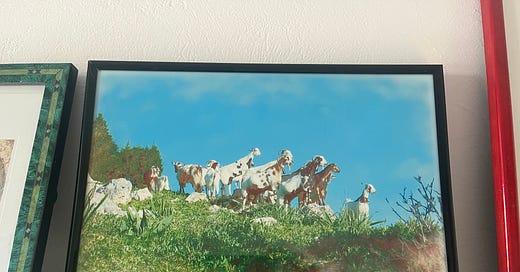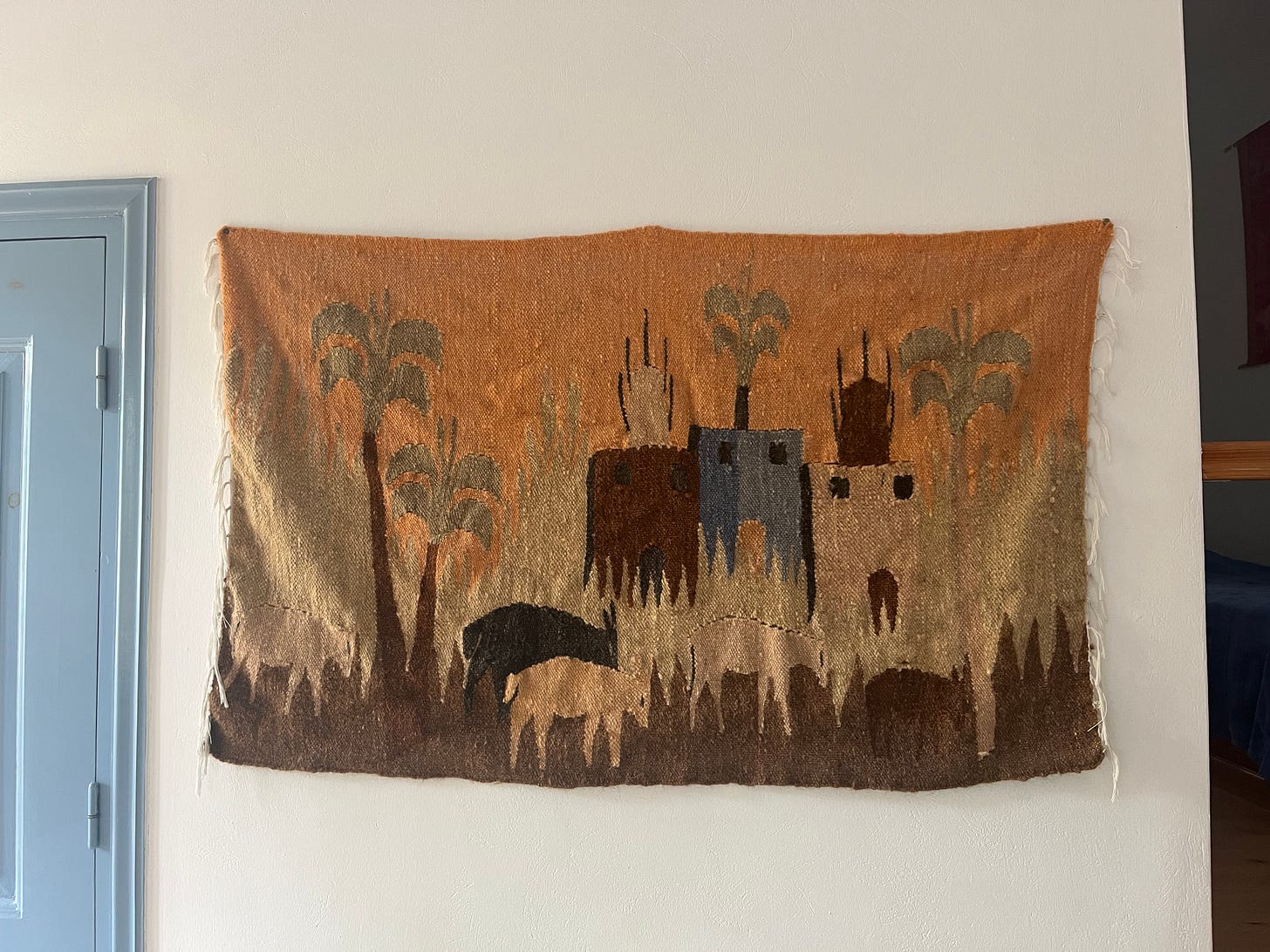In the room where I currently sit, I’m surrounded by depictions of goats. Hanging on the wall to my left are two prints of shepherds tending their flocks. Above the mantle rests a photo of a dozen standing on a precipice and gazing off-camera, their horns curved back like the ears of a submissive dog. And to my right is a tapestry of similar ruminants with their heads pointed at the grass.
If I looked only at the tapestry, I suppose I might think that the animals were donkeys instead. Their ears stand up in a donkey sort of way, though their tails are slightly too short. And if I looked only at the prints to my left, I might similarly wonder if they depicted sheep based on the roundness of their bodies.
But I happen to be on an island in eastern Greece, called Symi, that is overrun with goats. To the extent that any of the artwork in this apartment was made locally as a reflection of the artists’ environment, that’s what the animals would be. For the sake of this essay, I’ll ask that you permit my assumption.
After all, none of these animals are actual goats. All of them are, at least to my understanding, depictions of them. And each animal shows up differently based on the methods used by each artist.
The photograph presents the most easily-understood rendering. Its lines are crisp, and the contours of the goats’ features unmistakable. The prints are perhaps second. Although I admit the shepherds could be herding sheep, the general scene is apparent.
Finally, the tapestry. The size of the woolen yarn presents an obstacle in terms of how detailed the animals can be. But, like the prints, the scene is clear: a herd of grazing animals surrounded by foliage and buildings.
All three types of artwork may be representing the same, or very similar, subjects. But they manage to leave distinct impressions in part due to the media each artist employs.
As it happens, I’ve recently become obsessed with a note near the end of “Letter to an Old Poet,” the closing track to the boygenius album. In my research, I stumbled upon a piano version. I’m not sure I would love it on its own without having heard the original first. But, given my obsession, I found it reached an even higher level of beauty in its simplicity.
Done right, a song cover can transform the original. Each artist’s voice and instruments are media that carry the material to a new form.
When I first heard that Luke Combs had covered Tracy Chapman’s “Fast Car,” I was one of the eye-rollers. There is a way of viewing it—a white male country singer getting publicity for the work of a queer black woman—that has more than a tinge of appropriation.
But I was grateful to stumble upon Sherman Alexie’s note in which he recalled his own resonance with Chapman’s song as a “working class ballad” and his joy that it will reach a new generation of poor kids thanks to Combs.
The song is a good cover, regardless of how you view the optics.
At the risk of being reductive, I frequently notice similarities between the topics I circle and those discussed by writers I admire and follow, both here on Substack and elsewhere. On my worse days, this can feel intimidating. What space is there for me, a relatively new voice, if someone else—let along five, fifty, five hundred someone else’s—already said it better?
But after some rest and reflection, I come back to a sense of belonging. It turns out there is room for us all. I’ve not yet complained that this house in Greece has too many depictions of goats, or too much art of any kind for that matter.
I often joke that the summer I spent at an art school was the hardest I’ve ever worked. (For context, I also graduated from law school and practiced law in three states—things that are perhaps generally considered challenging.) On the first day, our painting instructor gave us two hours to depict a still life of oranges piled on a blue tablecloth. At the end of the session, we hung all twenty paintings on the wall.
From the same set of paints, the same canvasses, and the same paintbrushes arose twenty universes of color, texture, and shape. Did some compositions stand out more strongly than others? Yes. Were some of the oranges rendered more life-like, while others took on an abstract quality? Of course. Was there value in seeing each painting, both on its own but, perhaps more importantly, as part of the collective art-making enterprise we shared for that session?
I think you already know my answer to that.
-Julia
PS It feels great to be back after a brief hiatus. Nothing confirms my love of writing more than choosing to spend some of my vacation working on both fiction and nonfiction pieces from my iPhone and pocket journals alone. As always, I appreciate your support. Every like (♡), comment, and share helps.







Thank you!🩷